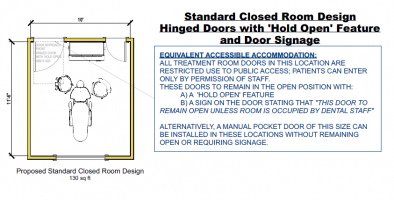C
Colockum Meghan
Guest
Hello,
IBC 2018 and ANSI 117.1 2017

Some architects are doing this in some states and I have adopted it for our design work. The main theme being that the dental treatment room is a an area of 'restricted use to public access in that the public / patient can only enter by permission of staff'.
The solution on a hinged door to avoid the requirement of 18" clear on the latch pull side of the door is to a) have a 'hold open' feature on the door and b) have a sign indicating as described above.
Your thoughts?
IBC 2018 and ANSI 117.1 2017

Some architects are doing this in some states and I have adopted it for our design work. The main theme being that the dental treatment room is a an area of 'restricted use to public access in that the public / patient can only enter by permission of staff'.
The solution on a hinged door to avoid the requirement of 18" clear on the latch pull side of the door is to a) have a 'hold open' feature on the door and b) have a sign indicating as described above.
Your thoughts?


